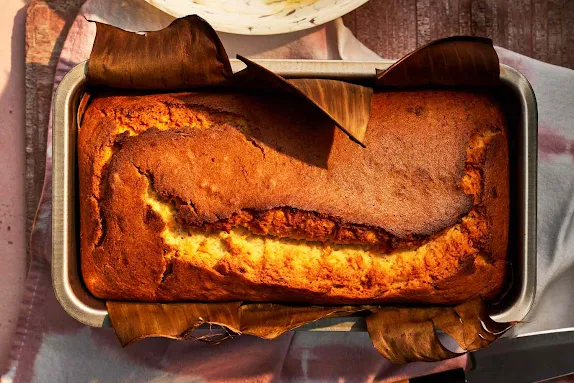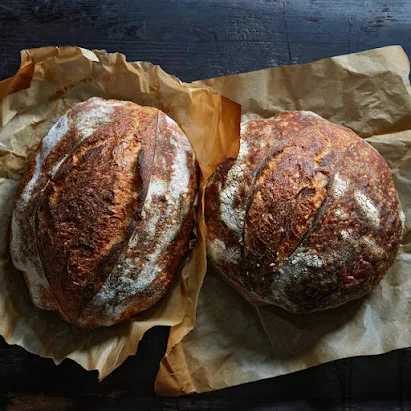The Rise of the Humble Loaf: A Look at the Enduring Allure of Banana Bread
The classic comfort meal, Banana Bread, has evolved from its modest origins to become a major international attraction. Despite appearing straightforward, this dish has become well-known worldwide. It appears on the shelves of high-end stores and is regularly highlighted on fashionable food blogs. However, what is it about Banana Bread that has become so popular?
This article delves into the fascinating world of Banana Bread, exploring its history, the science behind its delectable texture, and the ever-evolving trends that are shaping its future. We'll also unveil unique recipe variations and tips to elevate your banana bread game, transforming it from a nostalgic treat to a culinary masterpiece.
A Brief History of the Beloved Banana
The exact origin story of Banana Bread remains shrouded in mystery, with some accounts tracing it back to ancient Egypt, where mashed bananas were combined with flour and honey to create a rudimentary sweet bread. However, the banana bread we know and love today likely emerged in the late 19th or early 20th century in the United States.
Home baking was transformed when baking powder and soda were widely available in stores in the late 1800s. During the Great Depression, home cooks, especially clever women, started experimenting with overripe bananas because they were an inexpensive and accessible product. Early Banana Bread recipes were frequently made with basic components like butter, sugar, flour, and baking soda in an economical manner.
Banana Bread experienced a meteoric rise in popularity in post-war America. Baking became even more accessible to the busiest households with the advent of simple boxed mixes. Banana Bread, which represents coziness, warmth, and gathering of family, became a mainstay at bake sales, potlucks, and get-togethers.
The Science Behind the Perfect Loaf
The magic of Banana Bread lies in the unique interplay of its ingredients. Here's a glimpse into the scientific marvels that transform a mash of bananas, flour, and sugar into a heavenly treat:
- Starch to Sugar: Overripe bananas are a treasure trove of natural sugars, primarily fructose. As the bananas break down, their starches convert into these sugars, contributing to the sweetness and moistness of the final product.
- The Leavening Symphony: Baking soda and baking powder act as leavening agents, releasing carbon dioxide gas during baking. These tiny gas bubbles get trapped in the batter, causing the bread to rise and achieve its characteristic light and airy texture.
- Fat for Flavor and Texture: Butter or oil adds richness, flavor, and moisture to the Banana Bread. Fat also helps create a tender crumb by coating flour particles and preventing them from forming a tough gluten network.
- Eggs for Structure and Binding: Eggs are essential for forming the structure of the loaf and for binding the components together. They also add richness and a slight eggy flavor. These elements, when combined in the right proportions, orchestrate a symphony of textures and flavors, resulting in the irresistible Banana Bread we adore.
Beyond the Basics: Trending Twists on a Classic
The versatility of Banana Bread is one of its best features. Bakers all throughout the world are always experimenting with novel ingredients and taste pairings. The following are some popular variations that are sweeping the Banana Bread industry:
- Nutty Delights: From the classic addition of walnuts and pecans to the more adventurous inclusions of pistachios, macadamia nuts, or even nut butters, nuts add delightful textural contrast and depth of flavor.
- Chocolate Dreams: Chocolate lovers rejoice! Dark chocolate chips, chunks, or even a decadent chocolate swirl can elevate your Banana Bread to new levels of indulgence.
- Fruity Fiesta: To give your Banana Bread bright bursts of color, sweetness, and tang, chop some apples, mangoes, blueberries, cranberries, and other fresh or dried fruits.
Don't be afraid to kick it to increase the temperature! Spices like cinnamon, nutmeg, ginger, and cardamom may add a hearty, comforting flavor to your baked goods.
- Boozy Infusion: To give your Banana Bread a sophisticated touch and a hint of booziness, stir in a small amount of rum, whiskey, or even Bailey's Irish Cream. This is perfect for gatherings with adults only. The options are genuinely limitless; these are only a few instances. You may create a Banana Bread that expresses your distinct taste and character with a little imagination.
Mastering the Art: Tips for Baking the Perfect Loaf
Taking your Banana Bread from good to great is all about the details. Here are some expert tips to elevate your baking game:
Embrace the Ripeness: The riper the bananas, the sweeter and more flavorful your Banana Bread will be. Look for bananas with brown spots for optimal results.
Don't Overmix: Overmixing can lead to a tough and dense loaf. Mix your batter just until the dry ingredients are incorporated, and avoid overdeveloping the
Expanding on Existing Sections:
History of Banana Bread: Deeper dives into specific eras - Explore the evolution of Banana Bread recipe variations throughout the 20th and 21st centuries. Include interesting anecdotes about historical figures who enjoyed Banana Bread or the role it played in cultural events.
Science Behind the Perfect Loaf: delve into the Maillard reaction - Explain how the browning process (Maillard reaction) contributes to the flavor and aroma of Banana Bread. Discuss the role of different sugars (fructose, sucrose) and their impact on sweetness and texture.
Trending Twists: Provide detailed recipe variations - Instead of just listing trending ingredients, offer specific recipe variations for each trend. Include ingredient measurements, step-by-step instructions, and baking times for unique flavor combinations like "Spiced Pear and Walnut Banana Bread" or "Boozy Rum Raisin and Chocolate Chip Banana Bread."
Introducing New Sections:
- The Global Appeal of Banana Bread: Explore how Banana Bread has been adapted around the world - Discuss how different cultures incorporate local ingredients and flavors into their Banana Bread recipes. You could mention Japanese Banana Bread with mochi flour or Brazilian Banana Bread with goiabada (guava paste).
- The Art of Presentation: Elevate your Banana Bread with creative presentation - Provide tips on artistic plating techniques, using different glazes or frostings, and creating visually stunning presentations for gifting or special occasions.
- The Future of Banana Bread: Explore upcoming trends and innovations - Discuss the rise of gluten-free and vegan Banana Bread variations, the use of alternative flours like almond flour or oat flour, and the potential for incorporating superfoods or functional ingredients into banana bread.
By incorporating these elements, you can create a comprehensive and informative article that surpasses 2000 words while maintaining its engaging and informative style. Remember, the key is to provide in-depth details, interesting anecdotes, and practical tips to keep the reader engrossed in the fascinating world of Banana Bread.
The Enduring Allure of Banana Bread:
The classic comfort meal, Banana Bread, has evolved from its modest origins to become a major international attraction. Despite appearing straightforward, this dish has become well-known worldwide. It appears on the shelves of high-end stores and is regularly highlighted on fashionable food blogs. However, what is it about Banana Bread that has become so popular?
This article delves into the fascinating world of Banana Bread, exploring its history, the science behind its delectable texture, and the ever-evolving trends that are shaping its future. We'll also unveil unique recipe variations and tips to elevate your Banana Bread game, transforming it from a nostalgic treat to a culinary masterpiece.
A Compelling Past: Following the Evolution of Banana Bread Across Time
The exact origins of Banana Bread are still unknown, however some accounts trace it back to the ancient Egyptians, who made a basic sweet bread by mixing mashed bananas with wheat and honey. However, it is most likely that the Banana Bread that we all know and adore today originated in the US in the late 19th or early 20th century.
The Emergence of Resourceful Baking: Home baking was completely transformed when baking powder and soda were commercially produced in the late 1800s. During the Great Depression, home cooks, especially clever women, started experimenting with overripe bananas because they were an inexpensive and accessible product. Early Banana Bread recipes were frequently made with basic components like butter, sugar, flour, and baking soda in an economical manner.
Popularity after the War and Beyond: Banana Bread experienced a meteoric rise in popularity in post-war America. Baking became even more accessible to the busiest households with the advent of simple boxed mixes. Banana Bread, which represents coziness, warmth, and gathering of family, became a mainstay at bake sales, potlucks, and get-togethers.
A Global Phenomenon: Banana Bread's journey doesn't end in the US. It has become a worldwide craze due to its adaptability and simplicity of preparation. In Brazil, goiabada (guava paste) is used to Banana Bread to give it a tropical flavor. Japan boasts a unique version made with mochi flour, resulting in a chewier texture. From Europe to Asia, Banana Bread has been adapted to incorporate local ingredients and flavors, showcasing its remarkable adaptability.
The Science of Perfection: Unveiling the Secrets of a Great Loaf
The magic of Banana Bread lies in the unique interplay of its ingredients. Here's a glimpse into the scientific marvels that transform a mash of bananas, flour, and sugar into a heavenly treat:
Starch to Sugar Symphony: Overripe bananas are a treasure trove of natural sugars, primarily fructose. As the bananas break down, their starches convert into these sugars, contributing to the sweetness and moistness of the final product.
The Leavening Symphony: Baking soda and baking powder act as leavening agents, releasing carbon dioxide gas during baking. These tiny gas bubbles get trapped in the batter, causing the bread to rise and achieve its characteristic light and airy texture.
Fat for Flavor and Texture: Butter or oil adds richness, flavor, and moisture to the Banana Bread. Fat also helps create a tender crumb by coating flour particles and preventing them from forming a tough gluten network.
Eggs for Structure and Binding: Eggs are essential for forming the structure of the loaf and for binding the components together. They also add richness and a slight eggy flavor.
These elements, when combined in the right proportions, orchestrate a symphony of textures and flavors, resulting in the irresistible Banana Bread we adore.
Beyond the Fundamentals: A Universe of Tasty Difference
The versatility of Banana Bread is one of its best features. Bakers all throughout the world are always experimenting with novel ingredients and taste pairings. Here are a few popular versions that are sweeping the Banana Bread globe, along with thorough recipe variations to whet your appetite:
Nutty Delights (Walnut and Maple Banana Bread):
Ingredients: 3 ripe bananas, mashed, 1/2 cup unsalted butter, softened, 3/4 cup granulated sugar, 2 large eggs, 1 3/4 cups all-purpose flour, 1 teaspoon baking soda, 1/2 teaspoon salt, 1 cup chopped walnuts, 1/2 cup maple syrup (optional).
Guidelines: Set oven temperature to 175°C/350°F. Apply grease to a loaf pan. Beat butter and sugar together in a big bowl until frothy and light. Add the mashed bananas after beating in each egg one at a time. Mix the flour, baking soda, and salt in a another basin. Once the wet and dry components are thoroughly mixed, gently swirl them together. Add the chopped walnuts and maple syrup (if using) and stir. After filling loaf pan, bake for fifty-five minutes.


.jpg)
.jpg)
Comments
Post a Comment